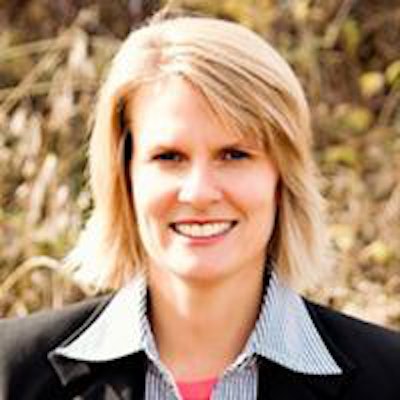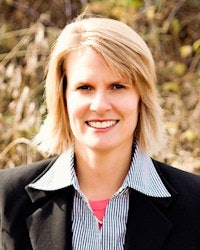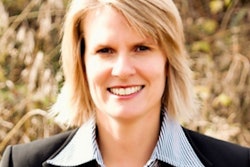
"Dr. Knowles, I think #3 is the problem for my emergency patient," said my student dentist one busy afternoon. "She points to that tooth, and I took an x-ray of it, but I cannot really see anything wrong with it. It must be the nerve going bad. She said it hurts pretty badly and has been keeping her awake. I am thinking endo on that tooth."
 Lisa Knowles, DDS.
Lisa Knowles, DDS.As the preceptor of this mentee, I looked at the x-ray with him and could not see any reason why #3 would be a problem. An old filling was in place, but nothing much else going on.
"Did you percussion test it?" I asked.
"It was a little sensitive," he said.
Unconvinced, I decided to take a look myself and see if anything caught my eye. I sat down, peered in at #3, and immediately noticed the problem. #2 had a medium-sized hole on the occlusal of an existing distal occlusal amalgam. On x-ray, only the mesial of #2 was in the picture, so the decay was not apparent. It was so obvious to me, but so not obvious to the student, because the patient fooled him.
This was a case of our patient totally providing misleading symptoms and my student dentist believing her. Of course, the misleading was unintentional on her part, but the point is -- never believe your patient.
Often when patients are in pain, we want to do everything we can to help them get relief. We want to believe them and resolve the issue quickly -- everyone does. But, we must prove it to ourselves that our diagnosis is just that -- our diagnosis. We must utilize our patients' information, fact check, dig a little deeper if needed, use our historical knowledge, and find the truth in our patients' words.
We took a bitewing x-ray, capturing #2 as well this time, and saw the problem more easily. Even when we know how to diagnose with preliminary testing, it is tempting to believe our patients' adamant pleas regarding their teeth. We must be strong and resist their persuasion until we feel comfortable with the information ourselves.
More often than not, our patients give us great, helpful information. However, this actually helps dull our diagnostic decision-making skills, because so often the patient is right. We learn to expect it and get caught off-guard when the patient is wrong.
Pain on her lower right
Another situation happened to me last week. An 80-year-old woman with dementia came into our practice with her caregiver. The patient complained of pain on her lower right -- in the gums -- and she felt like she broke a tooth. She rubbed the area with her tongue, and #30 revealed a roughened amalgam. I took out my handpiece and smoothed the area.
"That feels much better, but I thought I broke a tooth," she repeated.
I saw nothing else around the area she insisted had broken. Again, her tongue swept back and forth over #30. By this time, I wondered how much of the dementia played a factor in her complaint.
"Why don't you try this for now, and then we can always search for other possibilities if something still bothers you later," I offered.
"OK," she said.
But I heard the hesitation in her voice. It was her tone that tipped me off. Her genuine appeal to me that something still was not right.
"Let me look one more time," I said.
This time, I decided to floss her teeth because of moderate plaque buildup and because she said her gums hurt as well. As I rounded the #27, #28 area, a small piece of food slipped out of the mesial of #28, revealing a missing medial occlusal filling on #28.
Finally, I thought. I found it. It was nowhere near where her tongue suggested, and she seemed as surprised as I did when I told her it was a couple of teeth in front of the one we smoothed. Once I told her which tooth had the missing filling, she found it quickly with her tongue.
"Yes," she said. "That is it."
Why is it so hard for our patients to find the right tooth at the right time? I don't really know. For some people, it is easy. For others, it is difficult and frustrating.
3 tips for diagnoses
Three things help me diagnose with clarity and more certainty:
- I always have to prove my diagnosis to myself. Even if patients (or a student or an auxiliary staff member) are certain about the problematic tooth, I do not believe them at first.
- I listen for any hints of information in my patients' communication -- such as the tone or a slight facial expression. Tone often helps me understand a patient better. It often helps me believe or not believe patients depending on the situation.
- I leave myself open to the possibility of something different. In other words, I do not deal in absolutes -- despite how hungry my patient might be for this kind of answer.
Many patients have proved me wrong with unique tooth problems or reasons for pain. With premature and absolute ego-driven, doctor-type certainty, I would have made the wrong diagnosis on many occasions.
Instead, I ask more questions and take more x-rays if warranted. I also allow some space for intuitive thinking to occur. This is hard to describe, but I feel that something is not right based on the patient's voice and expressions, as well as my dental wisdom (it's my sixth sense, and I will explain that more in future articles).
Perhaps "never" is too strong of a word when it comes to believing our patients. But, the only thing I would change it to is "Never trust your patients -- at first. " Even my most trusted patients, the ones that never lie to me, come up with some tall tales and odd presentations of symptoms. I know my patients don't mean to lead me astray, and they don't mean to get angry with me when I have to tap or ice test their teeth a second time.
I know they want me to get the diagnosis right, and, because of that, I don't believe my patients -- ever -- at first.
Lisa Knowles, DDS, is the founder and CEO of IntentionalDental Consulting. For more information, contact her at [email protected] or 517-331-3688. Visit her blog site at Beyond32Teeth.com or website at IntentionalDental.com.
The comments and observations expressed herein do not necessarily reflect the opinions of DrBicuspid.com, nor should they be construed as an endorsement or admonishment of any particular idea, vendor, or organization.



















